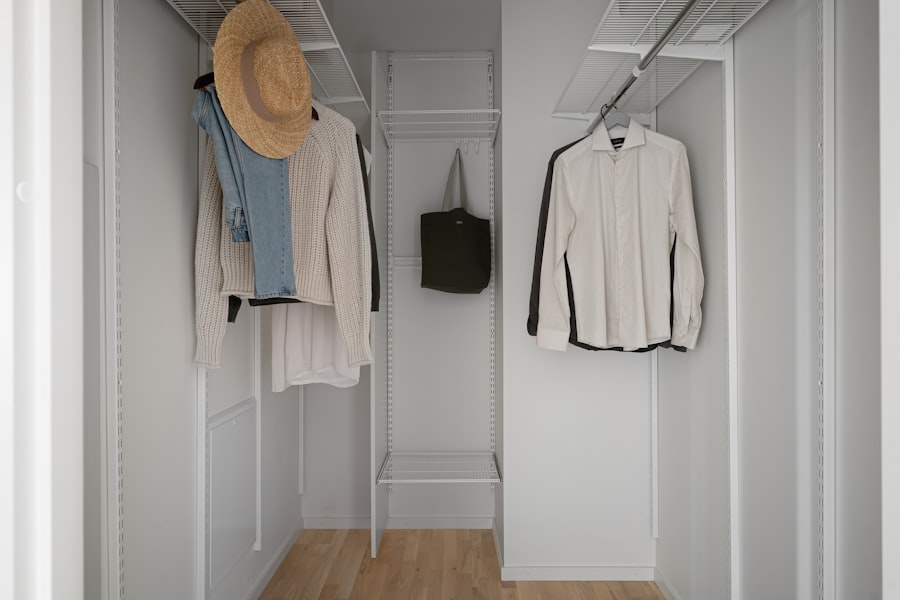Sustainable fashion is a concept that has gained significant traction in recent years, reflecting a growing awareness of the environmental and social impacts of the clothing industry. At its core, sustainable fashion seeks to minimize harm to the planet while promoting ethical practices throughout the supply chain. This approach encompasses various aspects, including the materials used, the production processes, and the treatment of workers involved in garment manufacturing.
By prioritizing sustainability, consumers can make informed choices that contribute to a healthier planet and a more equitable society. The rise of fast fashion has exacerbated issues such as waste, pollution, and exploitation of labor. As consumers increasingly recognize the consequences of their purchasing decisions, they are turning to sustainable fashion as a viable alternative.
This shift not only encourages responsible consumption but also fosters a culture of mindfulness regarding clothing choices. Understanding sustainable fashion is essential for anyone looking to make a positive impact through their wardrobe, as it empowers individuals to support practices that align with their values.
Key Takeaways
- Sustainable fashion focuses on reducing the environmental impact and promoting ethical practices in the fashion industry.
- Building a capsule wardrobe involves curating a collection of versatile and timeless pieces that can be mixed and matched for various outfits.
- Choosing quality over quantity means investing in well-made, durable clothing that will last longer and reduce the need for frequent replacements.
- Embracing second-hand and vintage finds promotes the reuse of clothing and reduces the demand for new production.
- Supporting ethical and fair trade brands ensures that workers are treated fairly and environmentally friendly practices are upheld in the production process.
Building a Capsule Wardrobe
Defining Your Personal Style
By focusing on essentials, one can cultivate a personal style that reflects individuality without succumbing to the pressures of fast fashion. The process of building a capsule wardrobe begins with assessing one’s current clothing collection. Individuals should evaluate which items they wear frequently and which ones remain untouched.
Building a Sustainable Wardrobe
This reflection allows for the identification of key pieces that serve as the foundation of the wardrobe. Once the essentials are established, it becomes easier to select additional items that complement existing pieces, ensuring that every addition is purposeful and aligns with the overall aesthetic.
The Benefits of a Capsule Wardrobe
Ultimately, a capsule wardrobe promotes sustainability by encouraging consumers to buy less while maximizing the potential of what they already own.
Choosing Quality Over Quantity

In the realm of sustainable fashion, choosing quality over quantity is paramount. Fast fashion often lures consumers with low prices and trendy designs, but these garments are typically made from inferior materials and lack durability. In contrast, investing in high-quality clothing means selecting items that are crafted with care and designed to last.
This not only reduces waste but also fosters a deeper appreciation for each piece in one’s wardrobe. When individuals prioritize quality, they contribute to a more sustainable fashion ecosystem by supporting brands that value craftsmanship and ethical production. Moreover, high-quality garments often come with timeless designs that transcend seasonal trends.
This longevity allows individuals to wear their favorite pieces for years, reducing the need for constant replacements. By cultivating a wardrobe filled with well-made items, consumers can enjoy the benefits of versatility and style without contributing to the cycle of overconsumption. Ultimately, choosing quality over quantity is a powerful statement against the throwaway culture perpetuated by fast fashion, encouraging a more thoughtful approach to personal style.
Embracing Second-Hand and Vintage Finds
| Benefits of Embracing Second-Hand and Vintage Finds | Statistics |
|---|---|
| Environmental impact | According to a study, buying second-hand reduces carbon emissions by 7% compared to buying new. |
| Cost savings | On average, buying second-hand items can save consumers 50-75% compared to buying new. |
| Unique style | 80% of consumers believe that vintage items offer a more unique and individual style compared to new items. |
| Reduction of waste | It is estimated that the average American throws away 81 pounds of clothing per year, embracing second-hand can help reduce this waste. |
Embracing second-hand and vintage clothing is another effective strategy for promoting sustainable fashion. Thrift stores, consignment shops, and online marketplaces offer a treasure trove of unique pieces that not only reduce waste but also allow individuals to express their personal style in distinctive ways. By opting for pre-loved garments, consumers can extend the lifecycle of clothing and divert items from landfills, making a positive environmental impact.
In addition to being eco-friendly, second-hand shopping can be an exciting adventure. The thrill of discovering hidden gems and one-of-a-kind items adds an element of fun to the shopping experience. Vintage clothing often carries its own history and character, allowing wearers to connect with the past while making a statement in the present.
By incorporating second-hand finds into their wardrobes, individuals can cultivate a style that is both sustainable and uniquely their own.
Supporting Ethical and Fair Trade Brands
Supporting ethical and fair trade brands is crucial for fostering a more sustainable fashion industry. These brands prioritize fair wages, safe working conditions, and environmentally friendly practices throughout their supply chains. By choosing to purchase from companies that adhere to these principles, consumers can play an active role in promoting social justice and environmental stewardship within the fashion sector.
Moreover, many ethical brands are committed to transparency, providing consumers with information about their sourcing and production processes. This transparency allows individuals to make informed choices about where their clothing comes from and how it was made. By supporting ethical brands, consumers not only invest in high-quality products but also contribute to a movement that seeks to redefine the standards of the fashion industry.
In doing so, they help create a demand for responsible practices that prioritize people and the planet over profit.
Incorporating Sustainable Fabrics

The choice of fabric plays a significant role in the sustainability of fashion. Many conventional textiles are produced using harmful chemicals and processes that contribute to environmental degradation. In contrast, sustainable fabrics such as organic cotton, Tencel, hemp, and recycled materials offer eco-friendly alternatives that minimize harm to both people and the planet.
By incorporating these materials into their wardrobes, consumers can support practices that prioritize sustainability while enjoying comfortable and stylish clothing. Additionally, sustainable fabrics often boast unique qualities that enhance their appeal. For instance, Tencel is known for its softness and breathability, making it an excellent choice for warm weather garments.
Hemp is not only durable but also requires less water and pesticides compared to conventional cotton. By choosing clothing made from sustainable fabrics, individuals can enjoy high-quality garments while contributing to a more responsible fashion industry.
Taking Care of Your Clothing
Taking care of clothing is an essential aspect of sustainable fashion that is often overlooked. Proper maintenance can significantly extend the lifespan of garments, reducing the need for frequent replacements. Simple practices such as washing clothes in cold water, air drying instead of using a dryer, and following care labels can make a substantial difference in preserving the quality of clothing.
By adopting these habits, individuals can minimize their environmental impact while enjoying their favorite pieces for years to come. Furthermore, repairing damaged clothing rather than discarding it is another way to practice sustainability. Learning basic sewing skills or seeking out local tailors can empower individuals to mend tears or replace buttons instead of tossing items aside.
This not only saves money but also fosters a sense of connection to one’s wardrobe. By taking care of clothing and investing time in maintenance, individuals contribute to a culture of sustainability that values longevity over disposability.
Repurposing and Upcycling Old Clothing
Repurposing and upcycling old clothing is an innovative way to breathe new life into garments that may no longer serve their original purpose. Instead of discarding items that have fallen out of favor or no longer fit, individuals can get creative by transforming them into something entirely new. For example, an oversized shirt can be turned into a stylish tote bag or old jeans can be repurposed into trendy shorts.
This not only reduces waste but also encourages creativity and self-expression. The upcycling movement has gained momentum in recent years as more people recognize the potential for creativity within their wardrobes. Social media platforms are filled with inspiring examples of individuals who have successfully transformed old clothing into fashionable pieces.
By sharing these projects, they encourage others to explore their own creativity while promoting sustainability. Repurposing clothing not only contributes to a more circular economy but also allows individuals to develop unique styles that reflect their personalities.
Renting and Borrowing Clothes
Renting and borrowing clothes has emerged as a popular alternative to traditional purchasing methods in the realm of sustainable fashion. This approach allows individuals to enjoy high-quality garments for special occasions without committing to long-term ownership. Rental services offer access to designer pieces at a fraction of the retail price, making it possible for consumers to wear luxurious items without contributing to overconsumption.
Additionally, borrowing clothes from friends or family can foster a sense of community while promoting sustainability. This practice encourages sharing resources and reduces the need for new purchases altogether. Whether it’s borrowing a dress for a wedding or renting an outfit for a vacation, these options provide flexibility while minimizing environmental impact.
By embracing rental and borrowing practices, individuals can enjoy diverse styles without compromising their commitment to sustainability.
Donating and Recycling Unwanted Items
When it comes time to part with unwanted clothing, donating or recycling items is an essential step in promoting sustainable fashion. Many organizations accept gently used clothing donations, providing them with new homes while supporting those in need. This practice not only extends the lifecycle of garments but also contributes to charitable causes within communities.
For items that are too worn or damaged for donation, recycling offers an alternative solution. Many textile recycling programs exist that can repurpose old clothing into new materials or products. By recycling unwanted items instead of sending them to landfills, individuals can play an active role in reducing waste within the fashion industry.
Donating and recycling unwanted clothing not only benefits the environment but also fosters a culture of generosity and responsibility among consumers.
Educating Yourself and Others about Sustainable Fashion
Education is key when it comes to promoting sustainable fashion practices within society. By taking the time to learn about the environmental and social impacts of the fashion industry, individuals can make informed choices that align with their values. This knowledge empowers consumers to advocate for change within their communities while encouraging others to adopt sustainable practices as well.
Sharing information about sustainable fashion with friends and family can create a ripple effect that extends beyond individual choices. Conversations about ethical brands, sustainable fabrics, and responsible consumption can inspire others to rethink their own shopping habits. By fostering awareness around sustainable fashion, individuals contribute to a collective movement toward more responsible practices within the industry.
Ultimately, education serves as a powerful tool for driving change and promoting a more sustainable future for fashion.
FAQs
What is a Conscious Closet?
A Conscious Closet refers to a wardrobe that is curated with a focus on sustainability, ethical production, and mindful consumption. It involves making thoughtful choices about the clothing and accessories we purchase and wear.
Why is it important to have a Conscious Closet?
Having a Conscious Closet is important because it promotes sustainable and ethical fashion practices. It helps reduce the environmental impact of the fashion industry, supports fair labor practices, and encourages mindful consumption.
How can I build a Conscious Closet?
To build a Conscious Closet, you can start by evaluating your current wardrobe, researching sustainable and ethical fashion brands, investing in high-quality and timeless pieces, and practicing mindful shopping habits such as buying second-hand or vintage items.
What are some benefits of having a Conscious Closet?
Some benefits of having a Conscious Closet include reducing environmental impact, supporting ethical and sustainable fashion practices, promoting fair labor conditions, and cultivating a more mindful and intentional approach to fashion consumption.
What are some tips for maintaining a Conscious Closet?
Some tips for maintaining a Conscious Closet include regularly assessing your wardrobe, prioritizing quality over quantity, supporting sustainable and ethical fashion brands, embracing minimalism, and practicing responsible clothing care and disposal.





